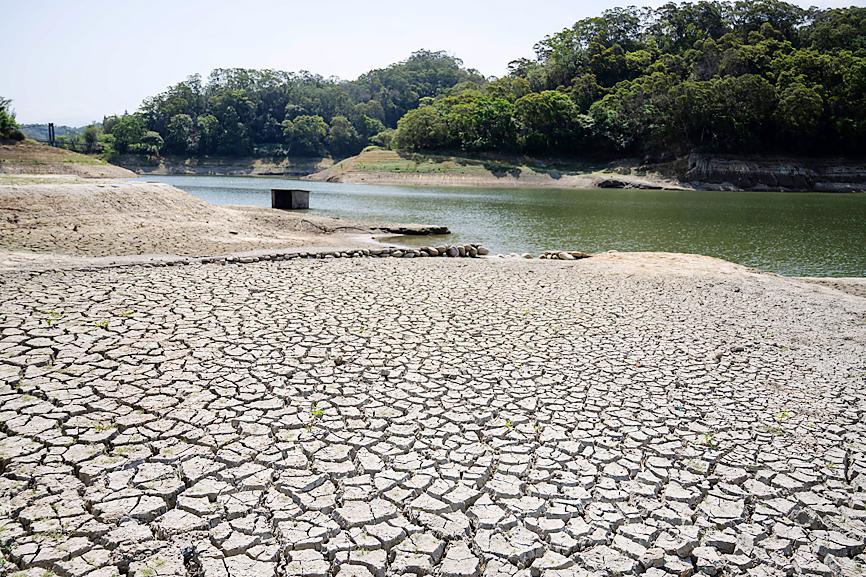A team of Academia Sinica researchers has found a correlation between the amount of rainfall and the frequency of earthquakes in Taiwan.
“The relationship between seismicity and hydrological loading cycles could provide valuable insights for improved regional hazard assessment,” the team wrote in its study, the lead author of which is Academia Sinica Institute of Earth Sciences research fellow Hsu Ya-ju (許雅儒).
A magnitude 6.4 earthquake in Kaohsiung’s Jiasian District (甲仙) on March 4, 2010, a magnitude 6.4 earthquake in Pingtung County’s Wutai Township (霧台) on Feb. 26, 2012, and a magnitude 6.6 earthquake in Kaohsiung’s Meinung District (美濃) on Feb. 6, 2016, all happened in the same season, Hsu said.

Photo: Billy H.C. Kwok, Bloomberg
Medium-level earthquakes in Taiwan occur more frequently in February and March, and less so in summer, she said.
The frequency of magnitude 2.5 to magnitude 6 earthquakes is higher in winter and early spring, and lower in the July-to-September period, Hsu said.
After identifying the seasonality of earthquakes, she analyzed the changes in water conservation and groundwater levels, Hsu added.
Changes in hydrological loading are a key factor driving the seasonal changes in seismicity, she said.
In Taiwan, there is usually more rainfall in summer due to typhoons and heat convection, increasing the hydrological loading on a thrust fault line, making it less likely to slide, she said.
When the loading decreases in winter, the fault is more likely to slide, which increases seismicity, she added.
“Taiwan is on a convergent plate boundary with abundant thrust fault earthquakes that can be used to test the influence of loading and unloading on earthquake modulation,” the study said.
While seismicity in eastern Taiwan shows the same seasonal pattern, the team’s findings are less pertinent to shallow earthquakes, at a depth of up to 18km, Hsu said.
The nation faces a prolonged dry spell this year, and the Central Weather Bureau has said seismicity so far this year is higher than previous years, corresponding with the team’s findings, she added.
The study, titled “Synchronized and asynchronous modulation of seismicity by hydrological loading: A case study in Taiwan,” was published in the journal Science Advances on Wednesday last week, and includes contributions from Canadian, Japanese and US researchers.
In related news, the bureau yesterday said rain is possible nationwide starting from today due to an approaching cloud band and a weather front, but it is unlikely to relieve the water shortage.
The cloud band is expected to move in from eastern China today and would bring rain, with brief showers possible in northern and eastern Taiwan, while precipitation is also likely in the mountainous areas in the west, particularly in the afternoon, the bureau said.
On Wednesday, a weather front is expected to approach Taiwan, with brief rain possible in northern and eastern Taiwan, it said.
The weather system is expected to strengthen and move quickly on Thursday, bringing more showers and thundershowers to the areas north of central Taiwan, it added.
However, the rain would not persist and would not be sufficient to relieve the water shortage, which has caused water to be rationed in parts of the nation, it said.
Heavier rainfall that could help to ease the dry conditions is unlikely until the upcoming plum rain season, which is expected to begin next month.

INVESTIGATION: The case is the latest instance of a DPP figure being implicated in an espionage network accused of allegedly leaking information to Chinese intelligence Democratic Progressive Party (DPP) member Ho Jen-chieh (何仁傑) was detained and held incommunicado yesterday on suspicion of spying for China during his tenure as assistant to then-minister of foreign affairs Joseph Wu (吳釗燮). The Taipei District Prosecutors’ Office said Ho was implicated during its investigation into alleged spying activities by former Presidential Office consultant Wu Shang-yu (吳尚雨). Prosecutors said there is reason to believe Ho breached the National Security Act (國家安全法) by leaking classified Ministry of Foreign Affairs information to Chinese intelligence. Following interrogation, prosecutors petitioned the Taipei District Court to detain Ho, citing concerns over potential collusion or tampering of evidence. The

‘FORM OF PROTEST’: The German Institute Taipei said it was ‘shocked’ to see Nazi symbolism used in connection with political aims as it condemned the incident Sung Chien-liang (宋建樑), who led efforts to recall Democratic Progressive Party (DPP) Legislator Lee Kun-cheng (李坤城), was released on bail of NT$80,000 yesterday amid an outcry over a Nazi armband he wore to questioning the night before. Sung arrived at the New Taipei City District Prosecutors’ Office for questioning in a recall petition forgery case on Tuesday night wearing a red armband bearing a swastika, carrying a copy of Adolf Hitler’s Mein Kampf and giving a Nazi salute. Sung left the building at 1:15am without the armband and apparently covering the book with a coat. This is a serious international scandal and Chinese

Seventy percent of middle and elementary schools now conduct English classes entirely in English, the Ministry of Education said, as it encourages schools nationwide to adopt this practice Minister of Education (MOE) Cheng Ying-yao (鄭英耀) is scheduled to present a report on the government’s bilingual education policy to the Legislative Yuan’s Education and Culture Committee today. The report would outline strategies aimed at expanding access to education, reducing regional disparities and improving talent cultivation. Implementation of bilingual education policies has varied across local governments, occasionally drawing public criticism. For example, some schools have required teachers of non-English subjects to pass English proficiency

TRADE: The premier pledged safeguards on ‘Made in Taiwan’ labeling, anti-dumping measures and stricter export controls to strengthen its position in trade talks Products labeled “made in Taiwan” must be genuinely made in Taiwan, Premier Cho Jung-tai (卓榮泰) said yesterday, vowing to enforce strict safeguards against “origin laundering” and initiate anti-dumping investigations to prevent China dumping its products in Taiwan. Cho made the remarks in a discussion session with representatives from industries in Kaohsiung. In response to the US government’s recent announcement of “reciprocal” tariffs on its trading partners, President William Lai (賴清德) and Cho last week began a series of consultations with industry leaders nationwide to gather feedback and address concerns. Taiwanese and US officials held a videoconference on Friday evening to discuss the